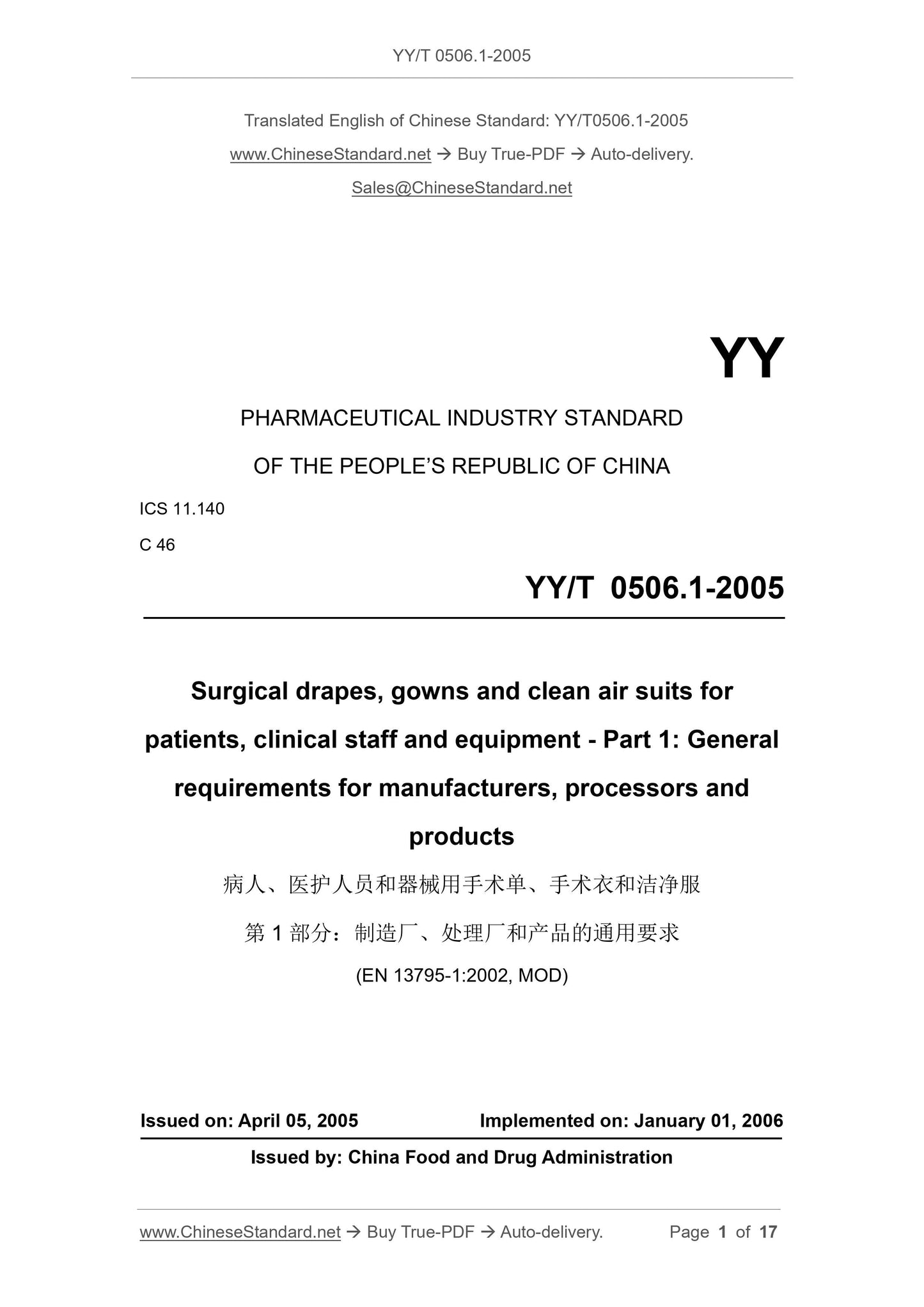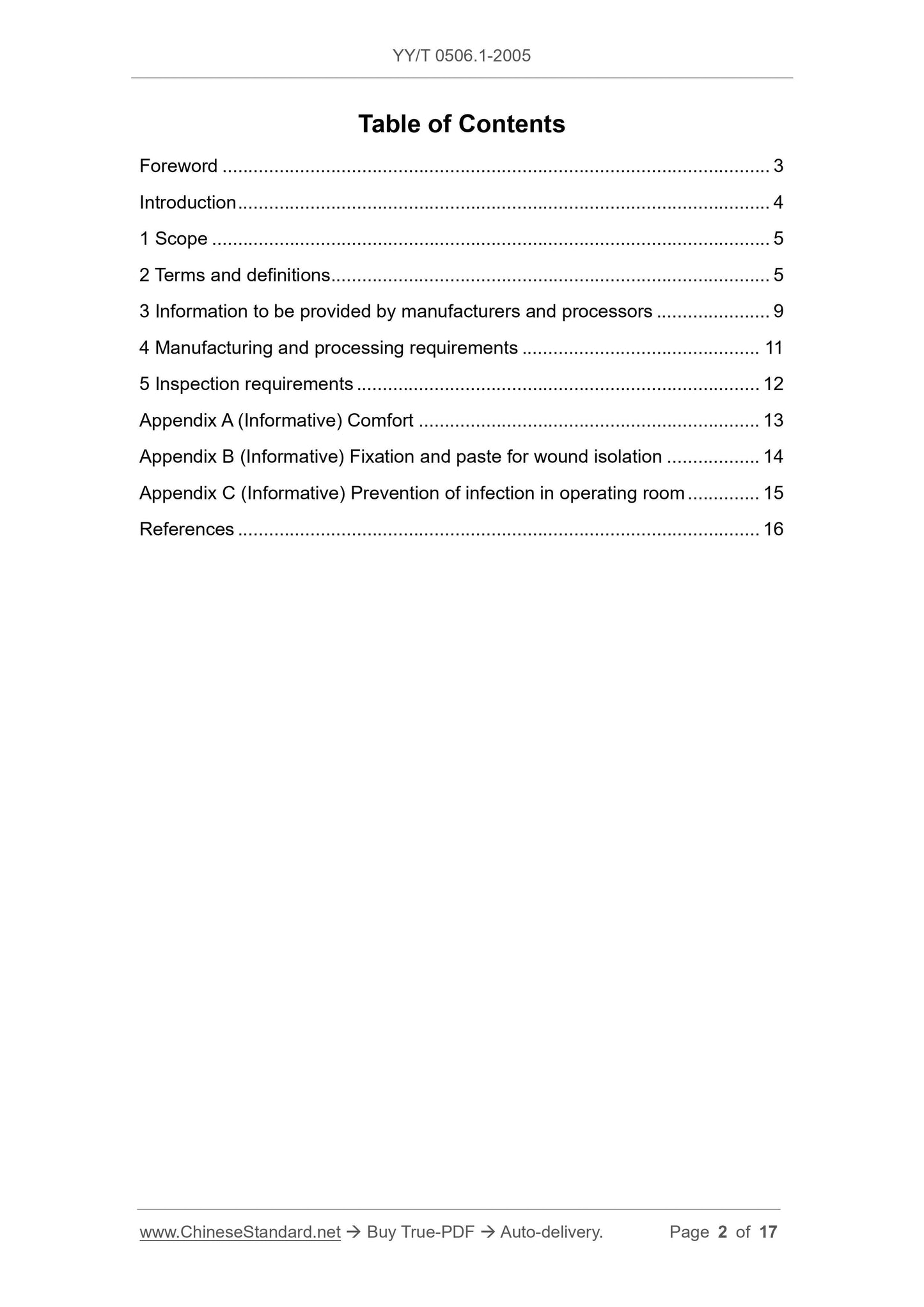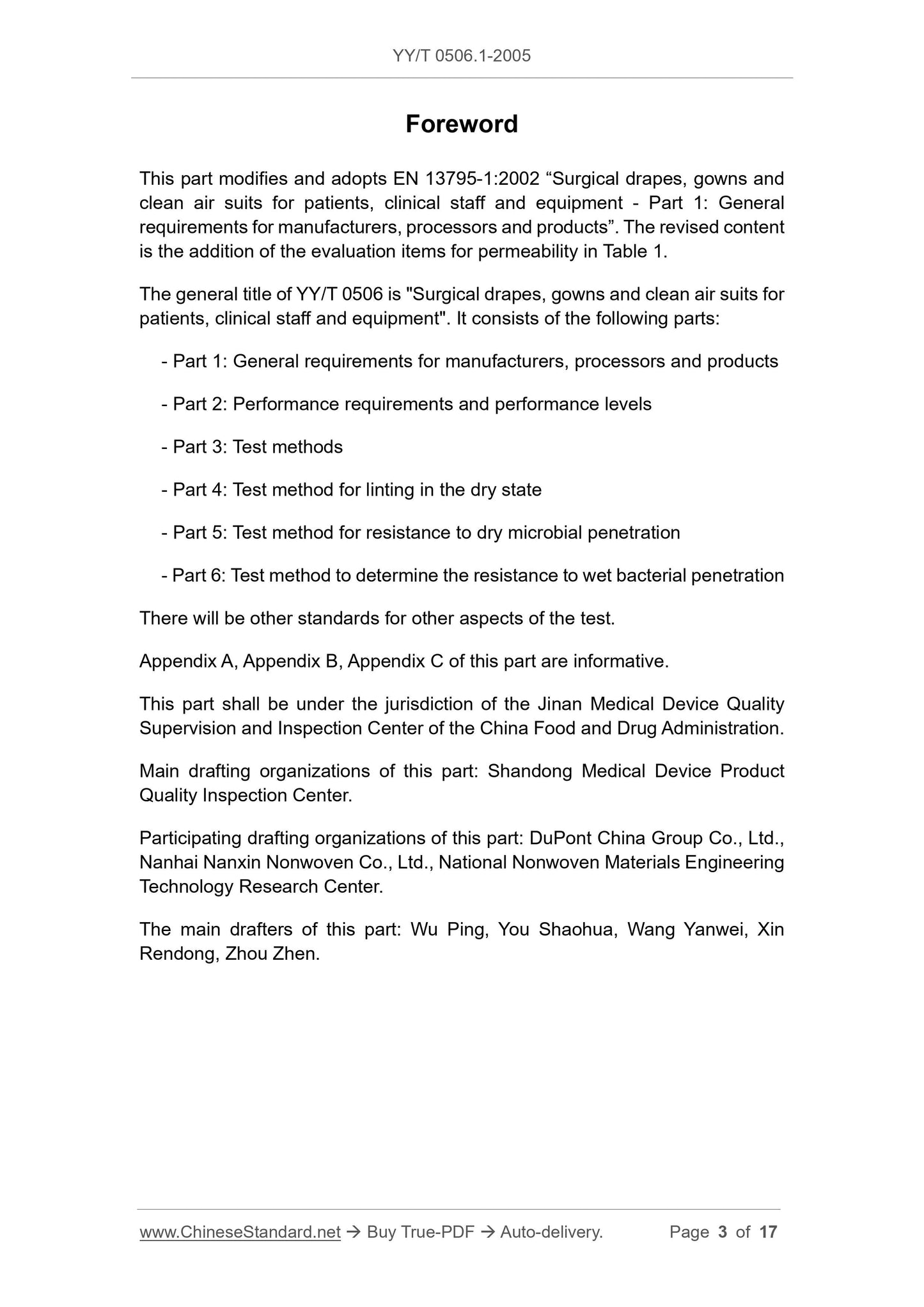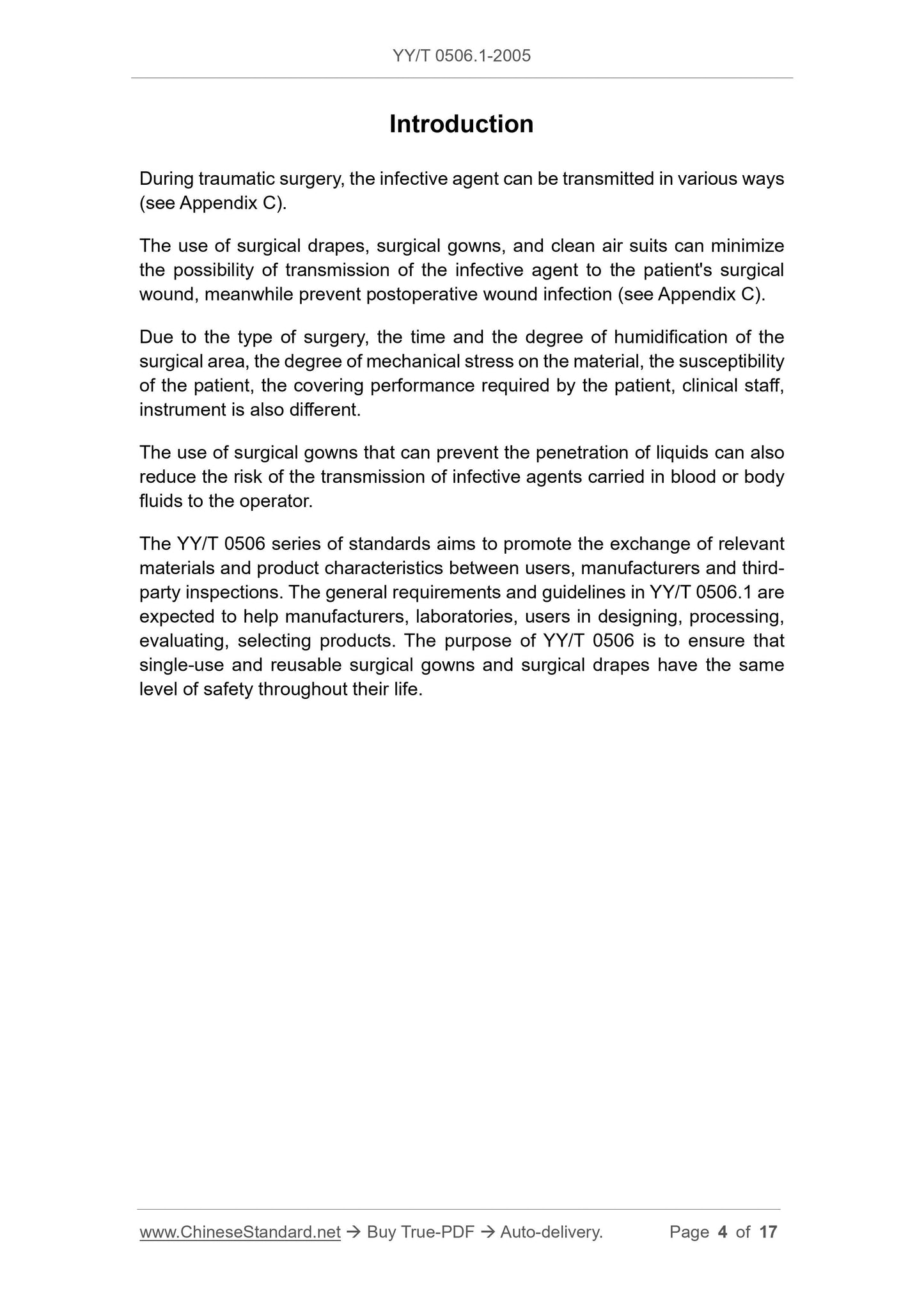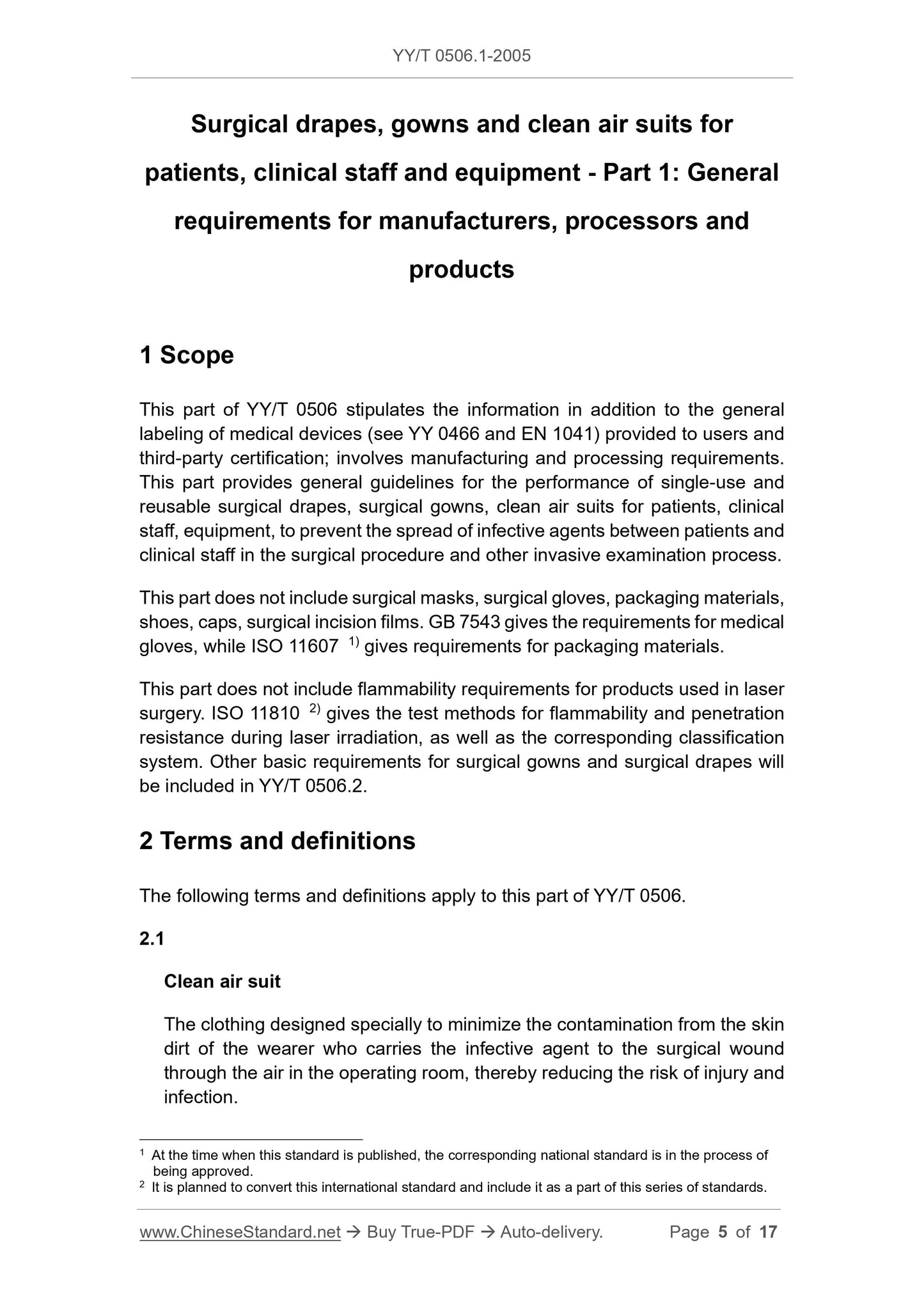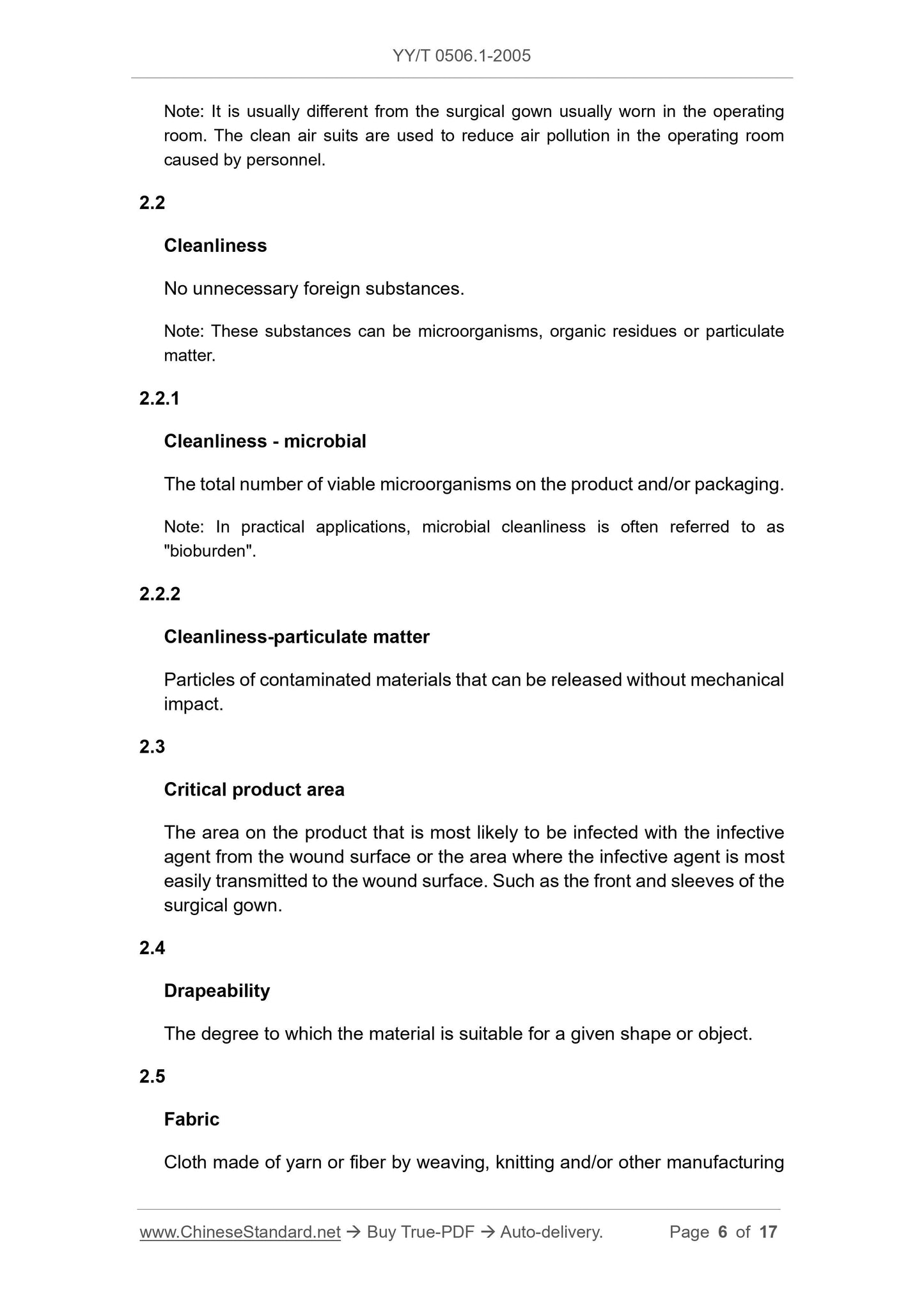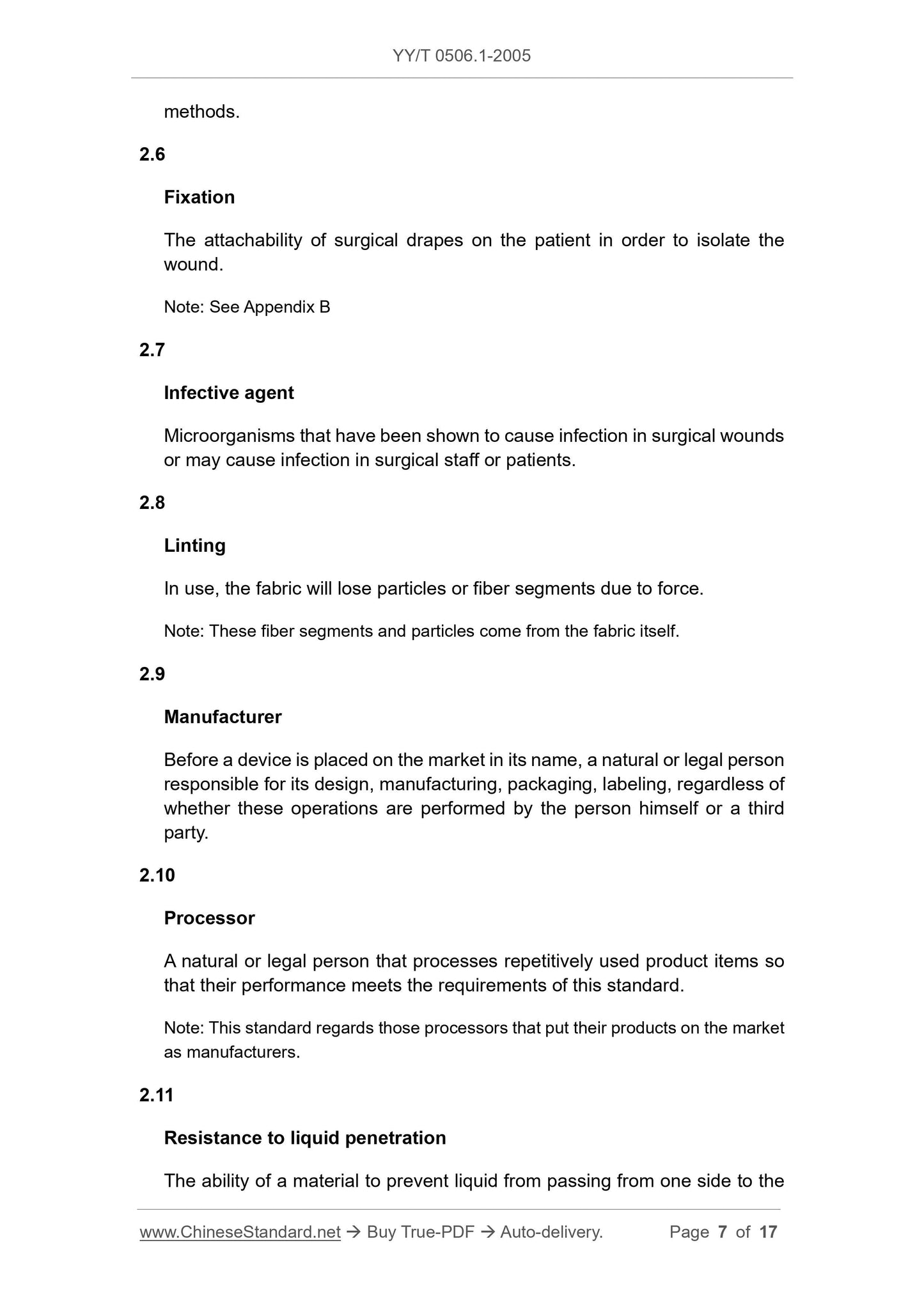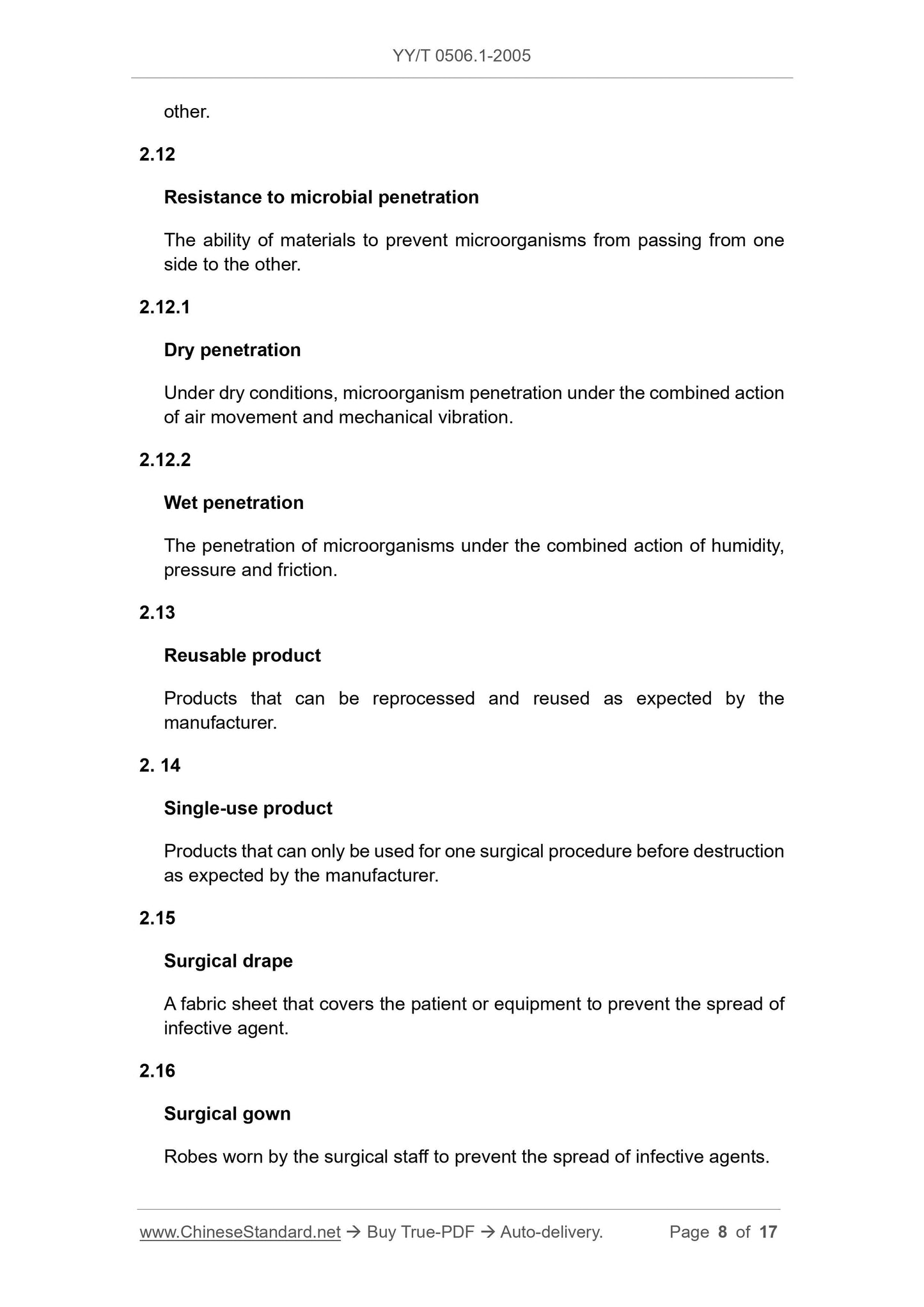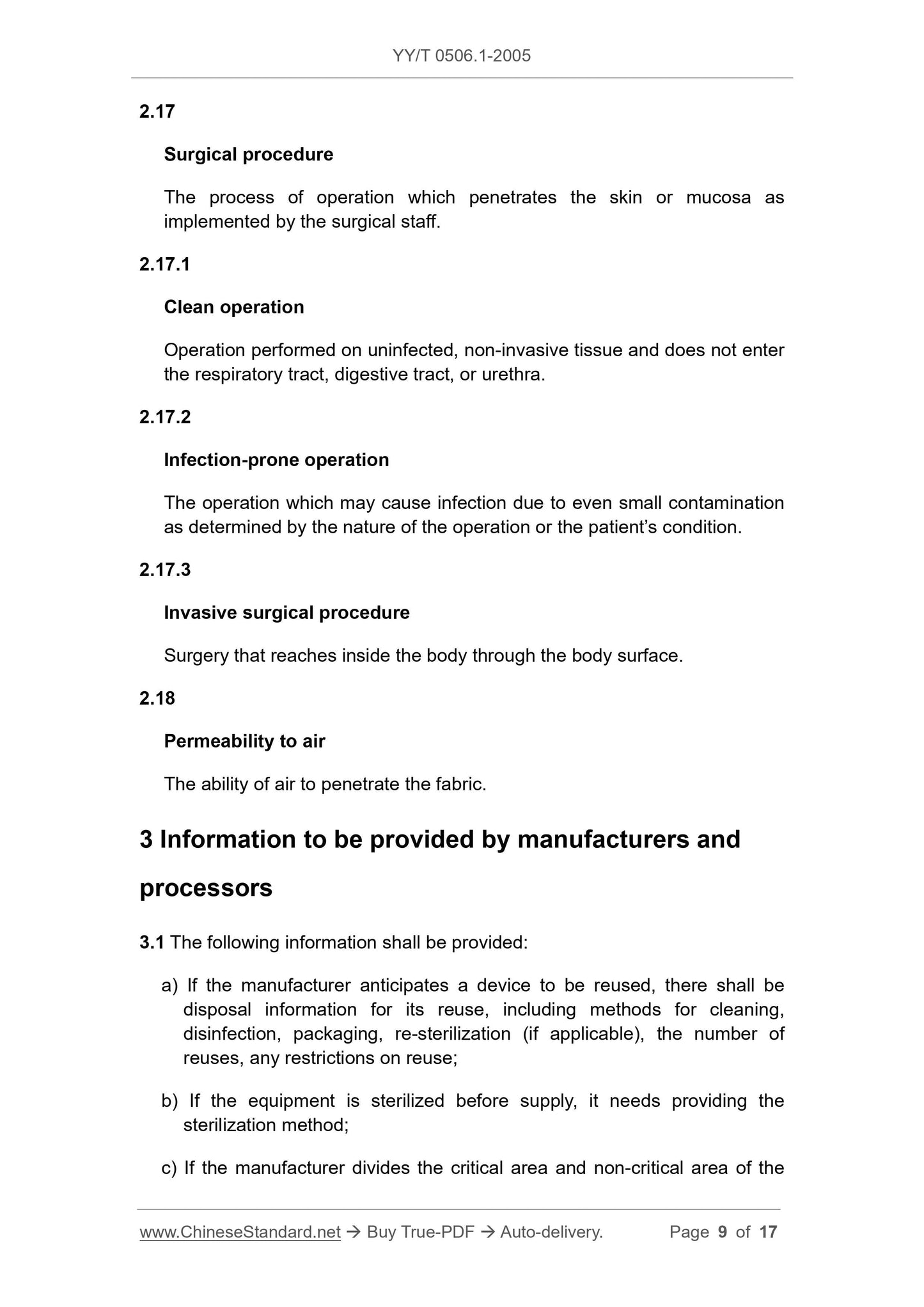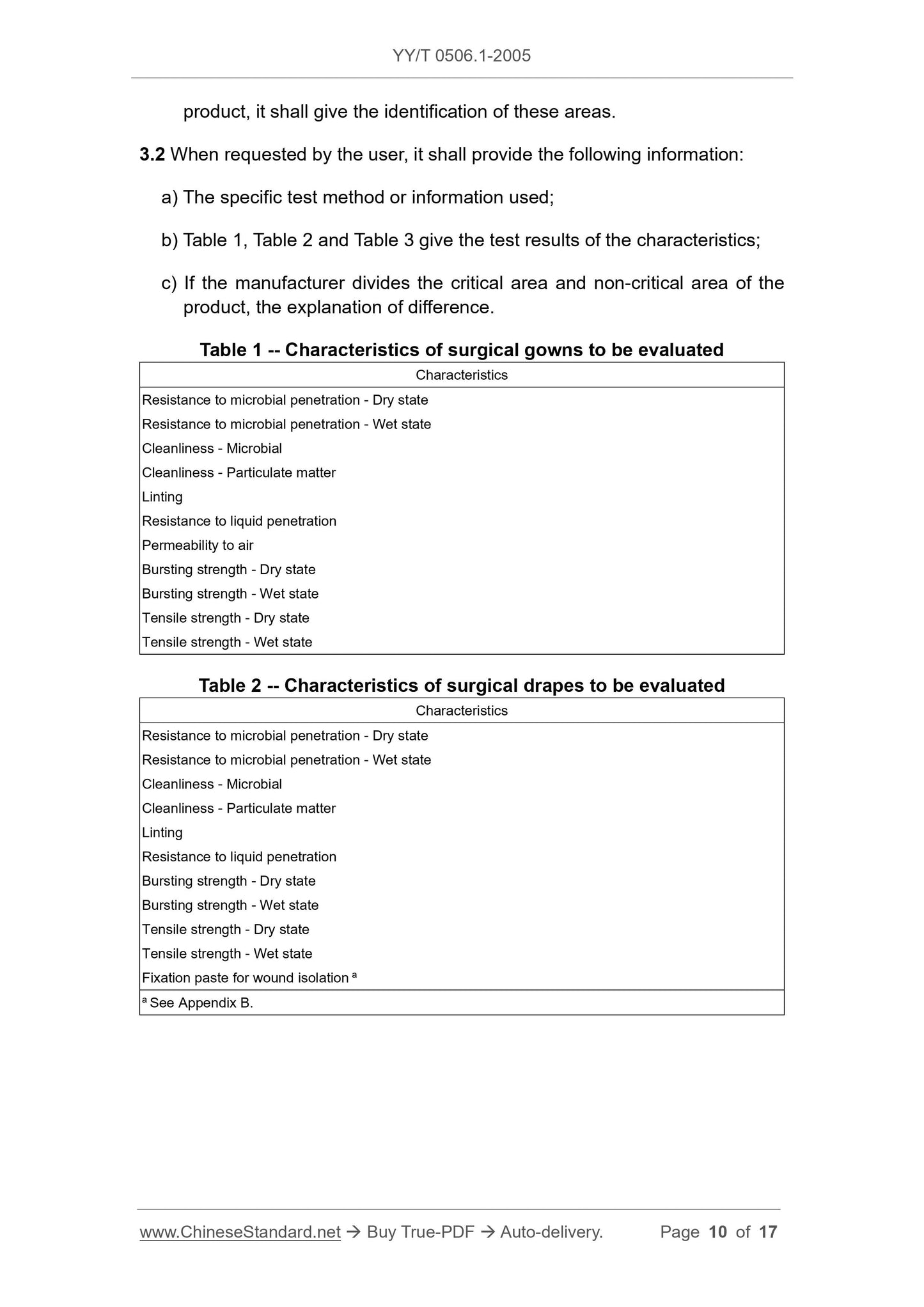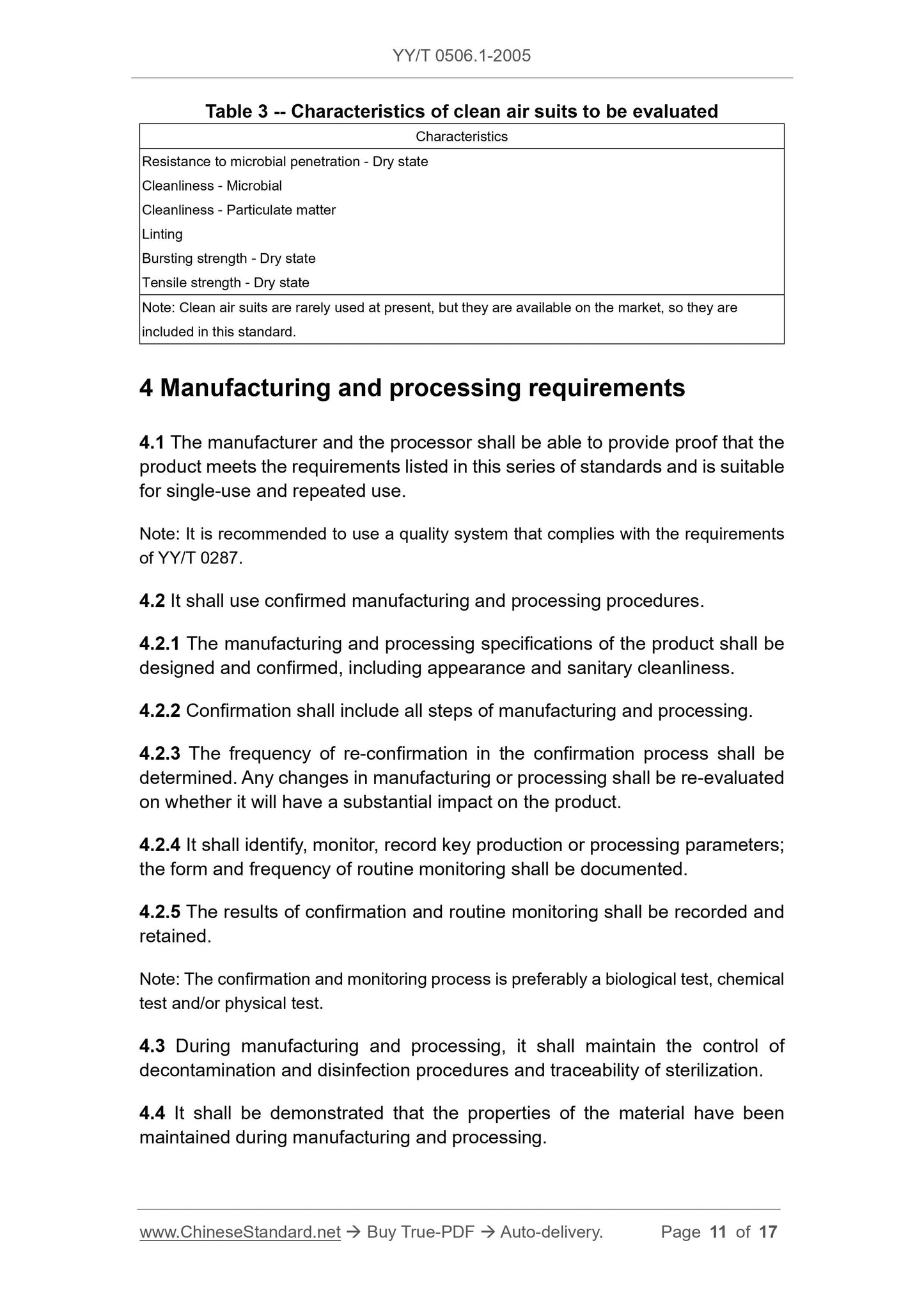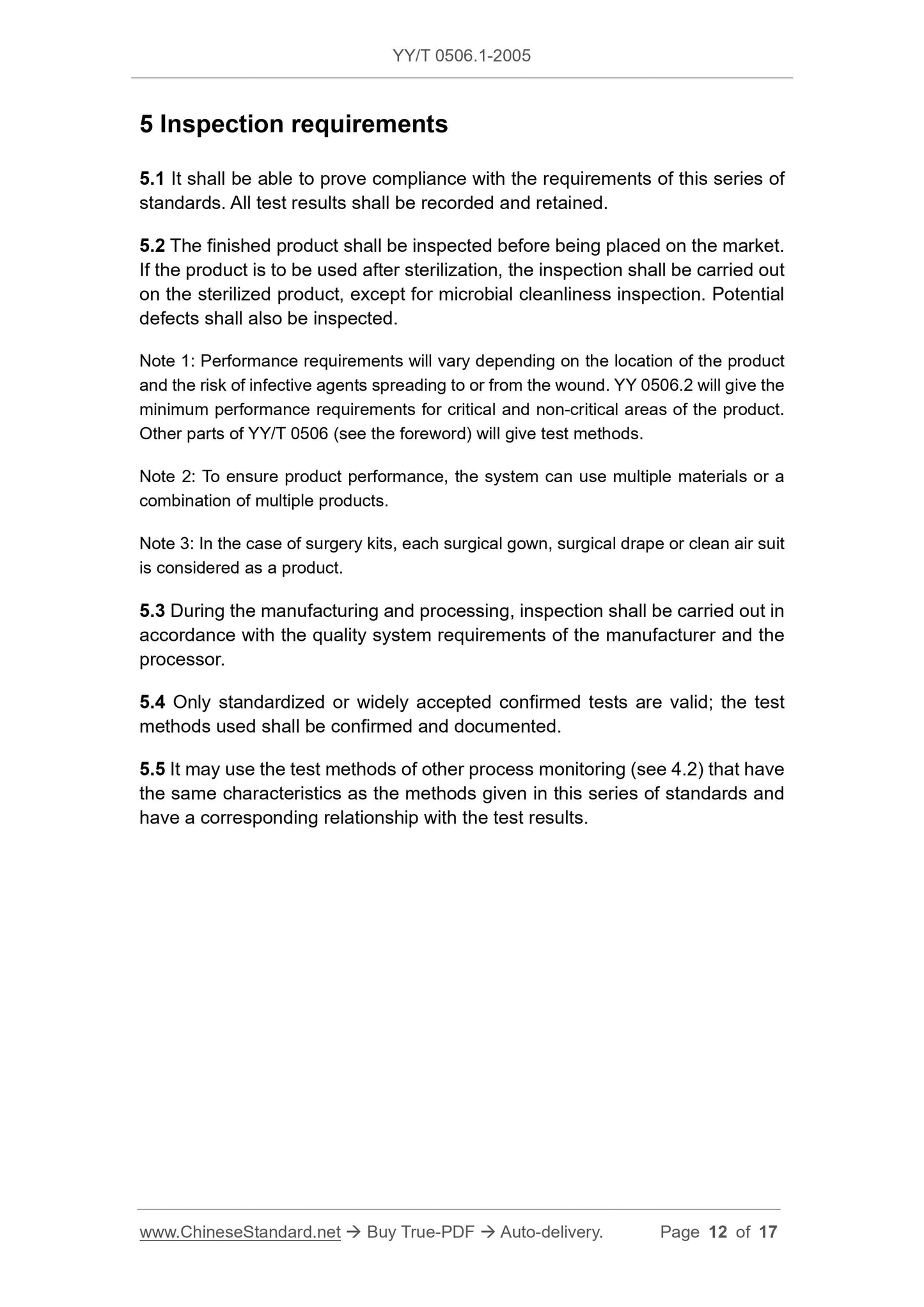1
/
von
12
PayPal, credit cards. Download editable-PDF & invoice in 1 second!
YY/T 0506.1-2005 English PDF (YYT0506.1-2005)
YY/T 0506.1-2005 English PDF (YYT0506.1-2005)
Normaler Preis
$210.00 USD
Normaler Preis
Verkaufspreis
$210.00 USD
Grundpreis
/
pro
Versand wird beim Checkout berechnet
Verfügbarkeit für Abholungen konnte nicht geladen werden
Delivery: 3 seconds. Download true-PDF + Invoice.
Get QUOTATION in 1-minute: Click YY/T 0506.1-2005
Historical versions: YY/T 0506.1-2005
Preview True-PDF (Reload/Scroll if blank)
YY/T 0506.1-2005: Surgical drapes, gowns and clean air suits for patients, clinical staff and equipment. Part 1: General requirements for manufacturers, processors and products
YY/T 0506.1-2005
PHARMACEUTICAL INDUSTRY STANDARD
OF THE PEOPLE’S REPUBLIC OF CHINA
ICS 11.140
C 46
Surgical drapes, gowns and clean air suits for
patients, clinical staff and equipment - Part 1: General
requirements for manufacturers, processors and
products
(EN 13795-1:2002, MOD)
ISSUED ON: APRIL 05, 2005
IMPLEMENTED ON: JANUARY 01, 2006
Issued by: China Food and Drug Administration
Table of Contents
Foreword ... 3
Introduction ... 4
1 Scope ... 5
2 Terms and definitions ... 5
3 Information to be provided by manufacturers and processors ... 9
4 Manufacturing and processing requirements ... 11
5 Inspection requirements ... 12
Appendix A (Informative) Comfort ... 13
Appendix B (Informative) Fixation and paste for wound isolation ... 14
Appendix C (Informative) Prevention of infection in operating room ... 15
References ... 16
Surgical drapes, gowns and clean air suits for
patients, clinical staff and equipment - Part 1: General
requirements for manufacturers, processors and
products
1 Scope
This part of YY/T 0506 stipulates the information in addition to the general
labeling of medical devices (see YY 0466 and EN 1041) provided to users and
third-party certification; involves manufacturing and processing requirements.
This part provides general guidelines for the performance of single-use and
reusable surgical drapes, surgical gowns, clean air suits for patients, clinical
staff, equipment, to prevent the spread of infective agents between patients and
clinical staff in the surgical procedure and other invasive examination process.
This part does not include surgical masks, surgical gloves, packaging materials,
shoes, caps, surgical incision films. GB 7543 gives the requirements for medical
gloves, while ISO 11607 1) gives requirements for packaging materials.
This part does not include flammability requirements for products used in laser
surgery. ISO 11810 2) gives the test methods for flammability and penetration
resistance during laser irradiation, as well as the corresponding classification
system. Other basic requirements for surgical gowns and surgical drapes will
be included in YY/T 0506.2.
2 Terms and definitions
The following terms and definitions apply to this part of YY/T 0506.
2.1
Clean air suit
The clothing designed specially to minimize the contamination from the skin
dirt of the wearer who carries the infective agent to the surgical wound
through the air in the operating room, thereby reducing the risk of injury and
infection.
1 At the time when this standard is published, the corresponding national standard is in the process of
being approved.
2 It is planned to convert this international standard and include it as a part of this series of standards.
methods.
2.6
Fixation
The attachability of surgical drapes on the patient in order to isolate the
wound.
Note: See Appendix B
2.7
Infective agent
Microorganisms that have been shown to cause infection in surgical wounds
or may cause infection in surgical staff or patients.
2.8
Linting
In use, the fabric will lose particles or fiber segments due to force.
Note: These fiber segments and particles come from the fabric itself.
2.9
Manufacturer
Before a device is placed on the market in its name, a natural or legal person
responsible for its design, manufacturing, packaging, labeling, regardless of
whether these operations are performed by the person himself or a third
party.
2.10
Processor
A natural or legal person that processes repetitively used product items so
that their performance meets the requirements of this standard.
Note: This standard regards those processors that put their products on the market
as manufacturers.
2.11
Resistance to liquid penetration
The ability of a material to prevent liquid from passing from one side to the
2.17
Surgical procedure
The process of operation which penetrates the skin or mucosa as
implemented by the surgical staff.
2.17.1
Clean operation
Operation performed on uninfected, non-invasive tissue and does not enter
the respiratory tract, digestive tract, or urethra.
2.17.2
Infection-prone operation
The operation which may cause infection due to even small contamination
as determined by the nature of the operation or the patient’s condition.
2.17.3
Invasive surgical procedure
Surgery that reaches inside the body through the body surface.
2.18
Permeability to air
The ability of air to penetrate the fabric.
3 Information to be provided by manufacturers and
processors
3.1 The following information shall be provided:
a) If the manufacturer anticipates a device to be reused, there shall be
disposal information for its reuse, including methods for cleaning,
disinfection, packaging, re-sterilization (if applicable), the number of
reuses, any restrictions on reuse;
b) If the equipment is sterilized before supply, it needs providing the
sterilization method;
c) If the manufacturer divides the critical area and non-critical area of the
Table 3 -- Characteristics of clean air suits to be evaluated
Characteristics
Resistance to microbial penetration - Dry state
Cleanliness - Microbial
Cleanliness - Particulate matter
Linting
Bursting strength - Dry state
Tensile strength - Dry state
Note: Clean air suits are rarely used at present, but they are available on the market, so they are
included in this standard.
4 Manufacturing and processing requirements
4.1 The manufacturer and the processor shall be able to provide proof that the
product meets the requirements listed in this series of standards and is suitable
for single-use and repeated use.
Note: It is recommended to use a quality system that complies with the requirements
of YY/T 0287.
4.2 It shall use confirmed manufacturing and processing procedures.
4.2.1 The manufacturing and processing specifications of the product shall be
designed and confirmed, including appearance and sanitary cleanliness.
4.2.2 Confirmation shall include all steps of manufacturing and processing.
4.2.3 The frequency of re-confirmation in the confirmation process shall be
determined. Any changes in manufacturing or processing shall be re-evaluated
on whether it will have a substantial impact on the product.
4.2.4 It shall identify, monitor, record key production or processing parameters;
the form and frequency of routine monitoring shall be documented.
4.2.5 The results of confirmation and routine monitoring shall be recorded and
retained.
Note: The confirmation and monitoring process is preferably a biological test, chemical
test and/or physical test.
4.3 During manufacturing and processing, it shall maintain the control of
decontamination and disinfection procedures and traceability of sterilization.
4.4 It shall be demonstrated that the properties of the material have been
maintained during manufacturing and processing.
Appendix A
(Informative)
Comfort
A.1 General
The concept of comfort is based on several different aspects, such as
physiological comfort, ease of exercise, or other factors that affect personal
satisfaction with the product
Fabric and design, especially hand washing clothes and operating room clothes,
shall minimize the physical stress generated during the work.
The climatic comfort of clothing depends on thermal insulation, permeability to
ai...
Get QUOTATION in 1-minute: Click YY/T 0506.1-2005
Historical versions: YY/T 0506.1-2005
Preview True-PDF (Reload/Scroll if blank)
YY/T 0506.1-2005: Surgical drapes, gowns and clean air suits for patients, clinical staff and equipment. Part 1: General requirements for manufacturers, processors and products
YY/T 0506.1-2005
PHARMACEUTICAL INDUSTRY STANDARD
OF THE PEOPLE’S REPUBLIC OF CHINA
ICS 11.140
C 46
Surgical drapes, gowns and clean air suits for
patients, clinical staff and equipment - Part 1: General
requirements for manufacturers, processors and
products
(EN 13795-1:2002, MOD)
ISSUED ON: APRIL 05, 2005
IMPLEMENTED ON: JANUARY 01, 2006
Issued by: China Food and Drug Administration
Table of Contents
Foreword ... 3
Introduction ... 4
1 Scope ... 5
2 Terms and definitions ... 5
3 Information to be provided by manufacturers and processors ... 9
4 Manufacturing and processing requirements ... 11
5 Inspection requirements ... 12
Appendix A (Informative) Comfort ... 13
Appendix B (Informative) Fixation and paste for wound isolation ... 14
Appendix C (Informative) Prevention of infection in operating room ... 15
References ... 16
Surgical drapes, gowns and clean air suits for
patients, clinical staff and equipment - Part 1: General
requirements for manufacturers, processors and
products
1 Scope
This part of YY/T 0506 stipulates the information in addition to the general
labeling of medical devices (see YY 0466 and EN 1041) provided to users and
third-party certification; involves manufacturing and processing requirements.
This part provides general guidelines for the performance of single-use and
reusable surgical drapes, surgical gowns, clean air suits for patients, clinical
staff, equipment, to prevent the spread of infective agents between patients and
clinical staff in the surgical procedure and other invasive examination process.
This part does not include surgical masks, surgical gloves, packaging materials,
shoes, caps, surgical incision films. GB 7543 gives the requirements for medical
gloves, while ISO 11607 1) gives requirements for packaging materials.
This part does not include flammability requirements for products used in laser
surgery. ISO 11810 2) gives the test methods for flammability and penetration
resistance during laser irradiation, as well as the corresponding classification
system. Other basic requirements for surgical gowns and surgical drapes will
be included in YY/T 0506.2.
2 Terms and definitions
The following terms and definitions apply to this part of YY/T 0506.
2.1
Clean air suit
The clothing designed specially to minimize the contamination from the skin
dirt of the wearer who carries the infective agent to the surgical wound
through the air in the operating room, thereby reducing the risk of injury and
infection.
1 At the time when this standard is published, the corresponding national standard is in the process of
being approved.
2 It is planned to convert this international standard and include it as a part of this series of standards.
methods.
2.6
Fixation
The attachability of surgical drapes on the patient in order to isolate the
wound.
Note: See Appendix B
2.7
Infective agent
Microorganisms that have been shown to cause infection in surgical wounds
or may cause infection in surgical staff or patients.
2.8
Linting
In use, the fabric will lose particles or fiber segments due to force.
Note: These fiber segments and particles come from the fabric itself.
2.9
Manufacturer
Before a device is placed on the market in its name, a natural or legal person
responsible for its design, manufacturing, packaging, labeling, regardless of
whether these operations are performed by the person himself or a third
party.
2.10
Processor
A natural or legal person that processes repetitively used product items so
that their performance meets the requirements of this standard.
Note: This standard regards those processors that put their products on the market
as manufacturers.
2.11
Resistance to liquid penetration
The ability of a material to prevent liquid from passing from one side to the
2.17
Surgical procedure
The process of operation which penetrates the skin or mucosa as
implemented by the surgical staff.
2.17.1
Clean operation
Operation performed on uninfected, non-invasive tissue and does not enter
the respiratory tract, digestive tract, or urethra.
2.17.2
Infection-prone operation
The operation which may cause infection due to even small contamination
as determined by the nature of the operation or the patient’s condition.
2.17.3
Invasive surgical procedure
Surgery that reaches inside the body through the body surface.
2.18
Permeability to air
The ability of air to penetrate the fabric.
3 Information to be provided by manufacturers and
processors
3.1 The following information shall be provided:
a) If the manufacturer anticipates a device to be reused, there shall be
disposal information for its reuse, including methods for cleaning,
disinfection, packaging, re-sterilization (if applicable), the number of
reuses, any restrictions on reuse;
b) If the equipment is sterilized before supply, it needs providing the
sterilization method;
c) If the manufacturer divides the critical area and non-critical area of the
Table 3 -- Characteristics of clean air suits to be evaluated
Characteristics
Resistance to microbial penetration - Dry state
Cleanliness - Microbial
Cleanliness - Particulate matter
Linting
Bursting strength - Dry state
Tensile strength - Dry state
Note: Clean air suits are rarely used at present, but they are available on the market, so they are
included in this standard.
4 Manufacturing and processing requirements
4.1 The manufacturer and the processor shall be able to provide proof that the
product meets the requirements listed in this series of standards and is suitable
for single-use and repeated use.
Note: It is recommended to use a quality system that complies with the requirements
of YY/T 0287.
4.2 It shall use confirmed manufacturing and processing procedures.
4.2.1 The manufacturing and processing specifications of the product shall be
designed and confirmed, including appearance and sanitary cleanliness.
4.2.2 Confirmation shall include all steps of manufacturing and processing.
4.2.3 The frequency of re-confirmation in the confirmation process shall be
determined. Any changes in manufacturing or processing shall be re-evaluated
on whether it will have a substantial impact on the product.
4.2.4 It shall identify, monitor, record key production or processing parameters;
the form and frequency of routine monitoring shall be documented.
4.2.5 The results of confirmation and routine monitoring shall be recorded and
retained.
Note: The confirmation and monitoring process is preferably a biological test, chemical
test and/or physical test.
4.3 During manufacturing and processing, it shall maintain the control of
decontamination and disinfection procedures and traceability of sterilization.
4.4 It shall be demonstrated that the properties of the material have been
maintained during manufacturing and processing.
Appendix A
(Informative)
Comfort
A.1 General
The concept of comfort is based on several different aspects, such as
physiological comfort, ease of exercise, or other factors that affect personal
satisfaction with the product
Fabric and design, especially hand washing clothes and operating room clothes,
shall minimize the physical stress generated during the work.
The climatic comfort of clothing depends on thermal insulation, permeability to
ai...
Share
